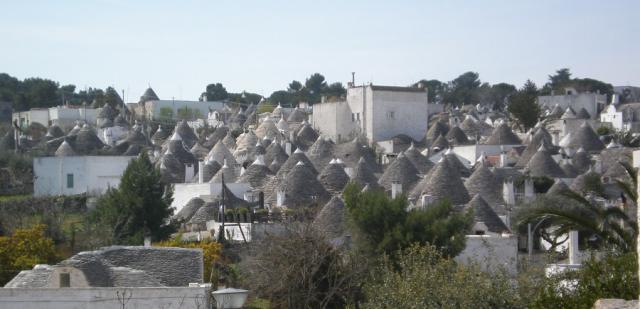Alborobello, the Only Town in the World Showing Trulli
|
Most ordinary buildings in the world use wooden beams to sustain the roof. Domed roofs, which use only stone, are more expensive and so are usually reserved for large buildings, cathedrals and the like. But wood may be so rare and expensive in some areas that stone domes are the only possible kind of roof. One such area is Apulia, in Southern Italy, where we can still find the kind of ancient Mediterranean building called the "trullo" (pl. "trulli"). The picture (made by the author) shows the central area of Alberobello, the only town in the world showing such a concentration of trulli. It looks like an accretion of limestone, a man-made land coral. A trullo is something that you can't ignore. The first time you see one, from a distance, it looks slender, elegant, even cute. With its conical roof, its round shape, it reminds you of Tolkien's Middle Earth, it looks like a place where hobbits could live. But, as you get close, you see that the trullo was never meant to be cute - it was never made for hobbits to live in. It is a huge mass of stone: thick walls, heavy roof. A trullo is a functional - even brutal - kind of architecture for an arid place where trees are rare. It uses only stone; no wood whatsoever. And if you have no beams to hold the roof, there are big limits to what you can do on a small budget. A trullo was meant as a place where peasants would live and they couldn't afford the domed architecture of cathedrals. A trullo must be small, otherwise the stone walls holding the dome would have to be truly gigantic. That is also the reason why it is round; to save material. You can make larger inner spaces by connecting several domes together, but the inside remains cramped. And also dark; the trullo has a door because there must be one, but windows would weaken the structure and so there aren't any or, at best, very small ones. That surely created problems of ventilation. Living in a trullo can't have been exactly the top in terms of comfort, at least the way we intend it today. But the thermal inertia of the thick walls offered to dwellers a degree of thermal comfort, winter and summer, that was impossible to obtain without air-conditioned and central heating. The limited space was not such a terrible limitation since, in a Mediterranean climate, you are supposed to live outside for most of the time and you'll go inside only at night and - in summer - to escape the heat of the day. A trullo is sturdy, cheap, practical and very well suited to hot climates. |




